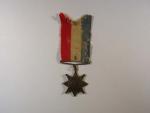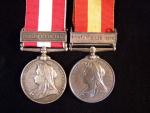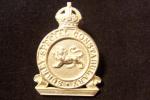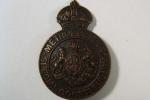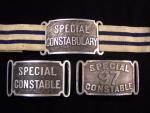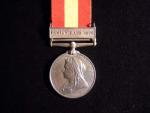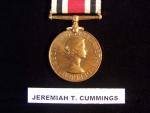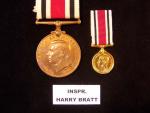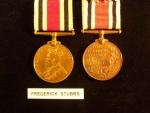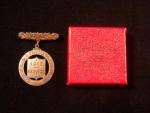-
Posts
6,486 -
Joined
-
Last visited
-
Days Won
10
Content Type
Profiles
Forums
Blogs
Gallery
Events
Store
Everything posted by Brian Wolfe
-
Hi Mervyn, You are correct this topic is well covered on the internet so I won't repeat it here. My wife has made an indepth study of the Fenian Raids and has purched the medals which reside in our collection. These are all named though I didn't list the recient's names with the two I posted earlier. The raids were meant to take Canada and then hold it to bargain with the British for a free Ireland. The Fenian army was made up of veterans of the American Civil War from both the North and the South. I think this in itself is pretty amazing considering that the Civil War had just ended. The American President Johnson supported this invasion, or so I have read, because he wanted the British to pay for their support of the South in the Civil War. Later he betrayed the Fenians and yet in the aftermath he told them his sympathies were with them. The reason for this betrayal was due to an agreement reached by the American and the British Governments for payments for the British support of the South. Sometimes it seems like writers paint the Fenians as naive amateurs however these were seasoned soldiers, while the taking of a country to hold it for ransom may be a bit naive they were acting out of patriotism for a free Ireland as well as believing they had the support of the American Government. Below is a medal from the Veteran's Association of 1866. This association was formed by Canadian Veterans who fought the Fenians and is much rarer than the Canadian General Service Medal. My wife added this to the collection about three years ago. The ribbon is the original, the medal is not named and would have been given out to the members of the association and therefore is not an official issue. Still it is an artifact from the period. Regards Brian
-
Hi James, You are correct the raids did continue into 1870. I'll attached a photo of the two bars for the Canada General Service Medal for service during the Fenian Raids. The CGS Medal with the 1870 bar came from the family whose Great-great-great-grandfather was awarded the medal, the ribbon is original. Regards Brian
-

Soviet restoration of medals
Brian Wolfe replied to bifter's topic in USSR: Soviet Orders, Medals & Decorations
Sir, you are my hero! My wife, being Italian, always stocks a good supply of olive oil in the kitchen and now I too have a use for it. Many thanks for a great tip. Regards Brian -
I have always believed that the Special Constabulary was founded due to the lack of police officers because of war service. This being the case I have no idea why the Metropolitian Service medal only has the date 1914. Perhaps one of the other members can shed some light on this. The bar for the national medal states 1914 - 1918, the medal itself being instituted 30 August 1919. Yet another medal mystery to be unravelled. Regards Brian
-
This is a Birmingham City Police Special Constabulary Reserve hat badge with the King's Crown. It measures 51 mm in height and 47 mm in width. It was held on to the hat by a pin that ran through two metal loops soldered on the back of the pin. There is no maker's mark on this specimen. Regards Brian
-
This is one of my favourite Special Constabulary hat badges in my collection. It is to the Metropolitian Specials. The badge has the King's Crown and measures 50 mm tall and 35 mm in width. The badge is held on by a round lug on the back that would be inserted through a button hole-like opening. The marker's name is on this lug and reads W.O.LEWIS, HOWARD ST., BIRMM. Whether this is WWI or WWII I am not sure and perhaps some of the members may be able to lend a hand with this information. Regards Brian
-
Here are three brassards form my collection. These were issued to the Special Constables and are made of aluminum. I understand these are quite generic and were used by many different municipalities. There is a round version that I believe has the city crest (I forget the city's name at the moment) and it seems that every time I see one for sale I am low on collecting funds. Such is the plight of a collector. Regards Brian
-

Soviet restoration of medals
Brian Wolfe replied to bifter's topic in USSR: Soviet Orders, Medals & Decorations
I've used vinegar with good results, and it makes me hungry. Regards Brian -
I didn't mean to say they were not effective. Against a slashing attack they are pretty well 100%. If the attacker was using a stabbing or thrusting move then he (or she) would have to hit the officer at 90 degrees to the surface of the vest and on top of that the officer's body will "give" as well so the momentum of the weapon would be absorbed. The example in the test was held quite rigid and there was almost no "give" to the area when it was struck. For their weight I think they are still your best bet. Here in Canada the use of a box knife (one of those cutters sold in harware stores with the retractable blade) is common on the streets. This is always a slashing weapon. It is used because the handle surface being groved will not produce good finger prints. I'm afraid this is getting way off topic and someone will probably point that out soon. Regards Brian
-

BOER WAR & WW1 GROUP
Brian Wolfe replied to Mervyn Mitton's topic in Great Britain: Orders, Gallantry, Campaign Medals
Hi Mervyn, Very nice group, thanks for posting. Regards Brian -
Yes, I noticed it was the same as the one I wore here in Canada. We used a dark blue carrier that was worn on the outside of the shirt of the same colour. The carrier was made to look like a shirt, fake buttons and all. To impress upon us that we were not indistructable because we were wearing a vest we were shown a demonstration where the vest was placed on two short piles of bricks and the area between the vest was unsupported. Then the instructor took out his Bic pen and drove to through the kevlar vest. No one spoke a word, just looked on in amazement. My vest was bullet resistant up to 44 mag., 12 gauge shot gun blast, puncture RESISTANT and slash proof. I still have my leather kevlar gloves somewhere and they too are puncture resistant and slash proof. A rifle bullet will zip right through the standard police vest, by the way. One of the best things about wearing the vests while in a vehicle is that they are blunt-force trama resistant. When in an accident the steering wheel will cause a lot of damage to the chest and rib cage. The vest will disapate the force and many times there is no injury caused by the steering wheel at all. You are correct it is the slower imact that allows the pen to penetrate. The saving grace is that when in wear it would not be very likely that an attacker would be able to strike the vest with a knife, or pen for that matter, at a perfect 90 degrees as was the case with the demonstration. Cheers and thanks for bringing back fond (?) memories. Brian
-
An interesting item and considering who wore it, quite rare. These were great to wear in the winter but pure hell in the heat of the summer. As I was reminded many a time, these are bullet resistant, resistant not bullet proof. By the way, did you know these can be pierced by a Bic pen? Regards Brian
-
The last in my series of "type" medals of the Special Constabulary is the Queen Elizabeth II pattern. This has the coinage bust as used on other medals after 1954. The coinage head used from 1953-54 was, to my knowledge, not used on the Specials. There was one quite rare pattern with the Queen wearing the Tudor crown but I have not been able to get one of these for my collection (yet?). As well there is a pattern issued to the Ulster Special Constabulary introduced in 1956 for 15 years of service. The reverse of this medal reflects that it was issued to the Ulster Special Constabulary. Another medal to elude my collection, and quite expensive if I may say so. Thanks for looking at my Specials Medals, I'll post more Special Constabulary items later. Regards Brian
-
The only obverse used for George VI on the Specials LSGC Medal was the Coinage profile. I am not sure if there exists an issue without the IND:IMP as this was used on other medals from 1937 - 48. After 1949 and until 1952 this was replaced with FID:DEF. I have not seen any without the IND:IMP but that is not to say there were none struck. Perhaps some of the members can shed so light on this question.
-
This is the standard Long Service and Good Conduct Medal issued to all Special Constables and was instituted on 30 August, 1919. I will not show the reverse with all of the medals in this series as they have remained the same right up to the present time. The comments are taken from the "Medals Yearbook": Awarded to all ranks in the Special Constabulary for 9 years unpaid service with more than 50 duties per annum. War service with at lease 50 duties counted triple. A clasp inscribed THE GREAT WAR 1914-18 was awarded to those who qualified for the medal during that conflict [i'll post some of these later in this thread]. Clasps inscribed LONG SERVICE, with the date, are awarded for additional ten-year periods. I have included name tags will all of the medals I will post so that there is no need to state them in my comments. The obverse of the first issue medal is of George V, Crowned bust in Coronation robes.
-
This is a Long Service Medal issued by Metropolitan Police to their Special Constables. I believe this was for 10 years service. The medal shown is a recent addition to my collection the box shown was purchased sometime ago along with an incomplete medal. The medal itself is 32mm in diameter and is unnamed. The maker's name is on the back of the suspension bar and reads, J.R.GAUNT, LONDON. There is no ribbon for these medals and they were meant to be attached by way of a pin on the back of the suspension bar. The box, in this case, was from the jeweller who supplied the medal. The lid of the box reads, John Taylor, Silversmiths Ltd., 5 Bream's Buildings, London E. C. 4.



